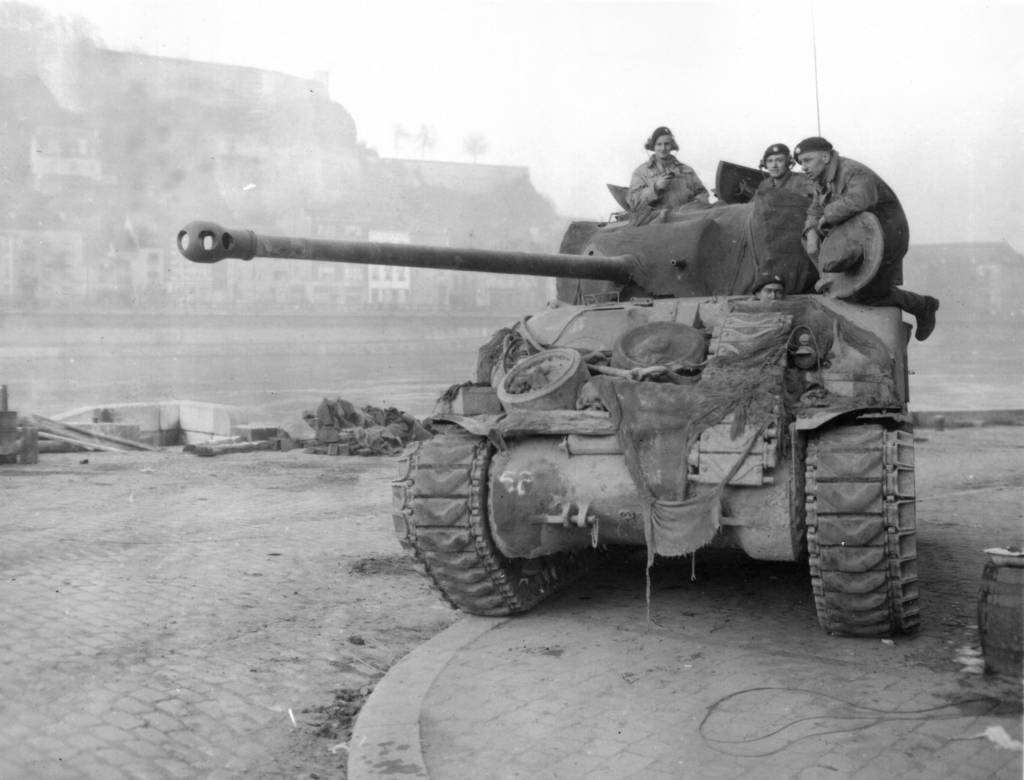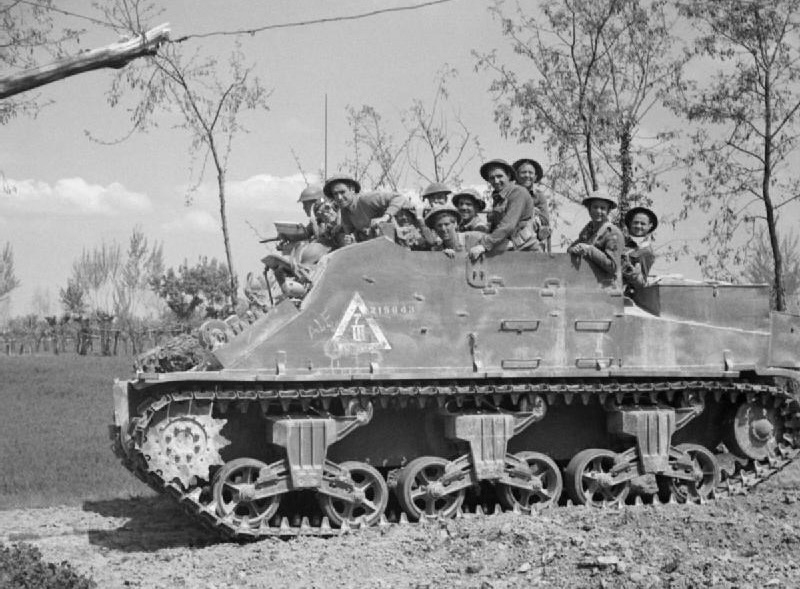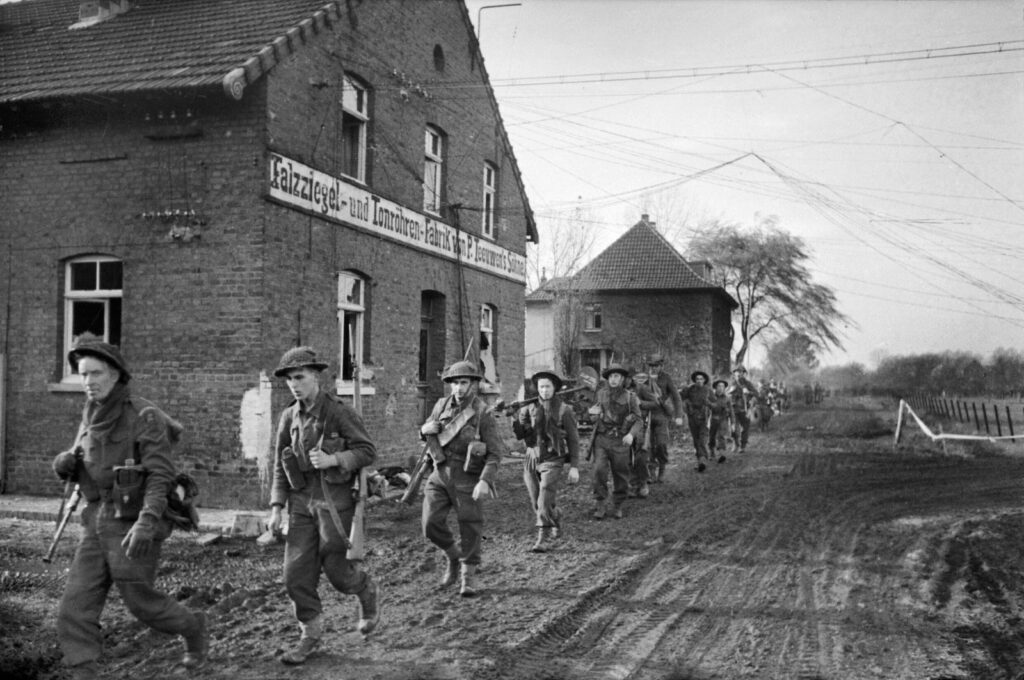Coordinating armor, infantry, and artillery to maximize combat power for achieving objectives at a minimal cost in lives.

Sherman Firefly Tank
This posting focuses on the evolution of British Army doctrine and the practice of the operational art in the ETO; specifically on how the British 21st Army Group developed operational and tactical doctrine for the seamless integration of armor, infantry, artillery, airpower, and engineers.

Churchill Infantry Support Tank
The British Army promulgated doctrine in the forms of the Field Service Regulations (FSR) and pamphlets. However, these documents never addressed the full range of doctrinal matters and were often skimpy on details. Some doctrinal matters went through evolutionary periods lasting decades. For example, doctrine regarding coordination between the tanks and infantry, and how to protect the armor against enemy anti-tank guns were not resolved until late 1944. Most importantly, FSR doctrine was not intended to be rigid, but rather guiding, with officers encouraged to widely modify its implementation based on their own professional experience and the unique features of the situation they were facing.
Montgomery saw a significant shortcoming in doctrinal development: the absence of guidance to commanders on how to train their troops on those principles. He was continually frustrated by subordinate senior commanders who were incapable of showing initiative and demonstrating flexibility — one reason why he always sought to maintain tight personal control of a battle to the point of micromanaging it.
The Interwar Years
Among the great challenges facing the British Army following the 1914-1918 war was determining the roles for the tank. Britain and France independently developed the tank in the mid-years of the Great War. Both armies did so to provide mobile firepower to enable the infantry to overcome the deadlock posed by the trenches and to penetrate defenses-in-depth. When employed in large numbers, the lumbering tanks of that era could fulfill that role. Tanks in themselves were not seen as capable of exploiting a breakthrough of the enemy defenses and, despite impressive experimentation, neither army developed an offensive combined arms capability in this conflict or during the interwar years that could be decisive on the battlefield.
However, Germany did so before the start of WWII, developing a practiced doctrine and fielding a truly integrated “combined arms team” of tanks, infantry, artillery, and engineers, supported by tactical airpower. Tested first in Poland, the Blitzkrieg led to complete collapse of the defense of Western Europe in short order in June 1940. Yet, this “Panzerwaffe” (armored force) of just ten panzer (armored) and six motorized divisions was a relatively small component of the much larger German army which continued to rely on marching infantry and horse-drawn artillery and supply throughout WWII. Although the panzerwaffe grew considerably during the war, it remained largely an infantry army that was never fully motorized.
Britain’s most important prewar decision was to completely motorize all components of its army, ending reliance upon horse-drawn artillery and supply. There was also a growing sense that armored forces had the potential to achieve a breakthrough of an enemy front, thereby deciding the outcome of a war. But there were many issues that remained unresolved. Left unanswered was whether tanks were an adjunct to the motorized army or a distinct new combat capability in themselves. If the latter, what was the proper relationship between armor and the infantry, as well as the artillery, engineers, and air power?
Uncertain of these answers, the British fielded three types of tank formations in the early years of the war. One was a heavily-armored, heavy gun armed, slow moving “infantry support” tank, that would reduce enemy strongpoints for the infantry. These “Tank Brigades” were assigned to support infantry divisions in offensive operations, but had no organic infantry. Armoured Brigades operated tanks less armored, but faster, intended to perform the traditional battlefield roles of the cavalry — maneuver and shock — and to counter enemy armor. Armoured brigades included a battalion of motorized infantry, but were clearly a tank-heavy formation. A problem soon recognized but easily solved was the difficulty of combining completely tracked fighting vehicles with the single organic infantry battalion in wheeled vehicles that were less capable of cross-country movement.
The West African Desert
The small British armored formations available to counter the Blitzkrieg were largely ineffective and this conflict raised even more questions about how to equip, organize, execute effective command and control, and field truly combined arms combat formations.
Nonetheless, in the Battle of Beda Fomm (February 1941), the British 7th Armoured Division in a daring move outflanked the Italian main line of resistance leading to the final collapse of the Italian army. This was a most successful victory achieved. But once the German Afrika Korps arrived in the desert, the British were almost continuously out-thought, out-maneuvered and out-fought. Once again, the central matter was the best use of tanks, anti-tank guns, infantry, and artillery in combined arms operations against German tanks and anti-tank guns.

Although the British won the critical Battle of El Alamein (23 October – 11 November 1942) that led to the eventual Axis defeat in North Africa, the battle did not develop as intended and left doubts as to the validity of the doctrine of the infantry making the breakthrough with armor and motorized infantry conducting the breakout and exploitation. Furthermore, this victory was possible only because of the US-provided M3 and M4 tanks, both capable of supporting the infantry and fulfilling the traditional maneuver and shock capabilities of the cavalry. Nonetheless, this victory provided Montgomery a very influential role in shaping doctrine for the remainder of the war.
Normandy to V-E Day
The doctrinal views of British commanders in Normandy depended largely upon their previous service before and during the war. Those who fought in North Africa and Italy had experiences that bore little similarity to the compartmented terrain of Normandy, and often stumbled in the early days of that campaign. Those who had fought only in France in 1940 or those who lacked any recent combat experience were influenced by the doctrine and training that they received in Britain. There was no single doctrine, nor one broadly shared experience that united their approach to operational operational planning and combat leadership.
Montgomery’s first WWII combat experience was command of an infantry division, caught up in the 1940 Blitzkrieg, that outperformed its counterparts. Following the fall of France, his division was recognized as one of the few in England that would have given a good performance had Hitler crossed the Channel. He deserves credit for achieving Allied victory in North Africa and Sicily, although much of the German Afrika Korps escaped at El Alamein, as did most of the Axis manpower and their equipment in Sicily.
Organization A most serious unresolved issue was the proper balance among tanks and infantry in armored formations. A related lingering problem was the how best to employ the separate “tank” brigades and “armoured brigades” that were intended to support infantry divisions Tank brigades now were equipped with the slow, large, heavy Churchill infantry-support tank that were attached to infantry divisions as needed. Armoured brigades were equipped with the general purpose US Sherman and British Cromwell tank. Cromwells also equipped the all-tank reconnaissance regiments of the armoured divisions. Making sense of all these doctrinal, organizational, and equipage issues again was going to have to take place during the fighting.
Based on his experience in North Africa, Montgomery concluded that armored formations must be concentrated for speedy and bold thrusts following the landing in Normandy. He sought tight control (“grip”) of the evolving battle to take advantage of emerging tactical opportunities or to respond to unanticipated moves by the enemy. His initial effort to achieve this with a streamlined chain of command over his commanders from corps to division to brigade. Nonetheless, this failed in the early battles around Caen — the problem being one of both command and control. (Command is the exercise of authority based upon certain knowledge to attain an objective. Control is the process of verifying and correcting activity such that the objective or goal of command is accomplished.) In simple terms, subordinate commanders did not have a single, shared understanding of what was expected of them. Another contributing factor was the compartmented terrain in Normandy which bore little resemblance to the open desert, as well as the training grounds in Great Britain.
A major factor was the flawed organizational structure of the armoured divisions, which was based upon armoured brigade of three tank regiments (battalions) and a single infantry battalion — now equipped with US-provided half-track armored troop carriers; a lorried (wheeled) infantry brigade of three infantry battalions; and a tank-equipped reconnaissance regiment (battalion). The armoured brigade lacked sufficient infantry and the motorized infantry brigade lacked organic armor and the half-track armored troop carriers, relying instead on wheeled, unarmored “Troop Carrier Vehicles.” Worse, both brigades tended to fight separate battles. The 11th Armoured Division addressed this by forming two “homogenous” combined arms brigades — each of two armored and two infantry battalions — by re-designating and re-tasking the armoured reconnaissance regiment as an armoured regiment. (Significantly, the two types of combat battalions in the division also paired units down to the lower troop and platoon levels.). Unfortunately, this did not happen until later in the campaign, in Operation Bluecoat, as the Allies commenced the operations leading to the breakout from Normandy. Fortunately, this became the normal operating procedure.
More Effective Weapons Another innovation that greatly improved combined arms operations was the introduction of self-propelled 17-pounder anti-tank guns in several variants, the Archer and a modified US M10 Tank Destroyer called the Achilles. In addition, some M4 and British Cromwell tanks were also equipped with the 17-pounder, and known as the Sherman Firefly and Challenger, respectively.
Britain first fielded the US-provided M7 105mm self-propelled howitzer at El Alamein. Dubbed the “Priest” due to its pulpit-like machine gun mount, others served in the ETO. In addition, the British and Canadians developed and the fielded the Archer, armed with the 25-pounder, the standard field gun of the British and Commonwealth Armies. These fully tracked self-propelled guns greatly improved indirect fire support for armored formations.
Debut of the Armored Personnel Carrier The first fully-tracked, Armored Personnel Carrier (APC) made its appearance in Operation Totalize (8-9 August 1944) when 72 lend-lease M7s were converted by British and Canadian Royal Electrical and and Mechanical Engineer units in Normandy by removing their 105mm howitzers to make room for infantry. Known as “Defrocked or Unfrocked Priests,” these first ever fully-tracked APCs enabled supporting infantry to go everywhere a tank could go. Later variants were conversions of the Canadian Ram tank and the US M4 Sherman tank with the turrets removed.

Notably, many of the above changes originated at lower levels of leadership and reflected a greater appreciation across all ranks for enhancing combined arms operations.
Montgomery’s Method of War
The Normandy Campaign was a defining point in the development of Montgomery’s method of war — his personal doctrine that he imposed on the British 21st Army Group. The concepts and techniques he practiced and sought to install in his subordinates in the ETO were based on his personality and personal experience in two world wars. A case can be made that it compensated for his self-perceived (but never acknowledged) shortcoming as a combat commander — that is, his greater skill at fighting set-piece battles rather than fluid ones.
Montgomery believed that, given the relative strengths and weaknesses of the German and Allied armies, victory could best be achieved not through the skill of his subordinate commanders, but rather through sustained competence at the operational level war, backed up and sustained by closely managed set-piece battles in which his forces sought victory at the operational rather than at the tactical level of war. This was driven by his belief that the British Army of Liberation — much like the British Expeditionary Force of the Great war — could not overcome German tactical proficiency. Rather than directly taking on the German strengths, he sought to exploit Germany’s relative weakness in industrial production that made it difficult to sustain its armies fighting on several fronts, particularly its difficulties in massing and maneuvering its panzerwaffen, and its loss of air superiority.

Although this seems to downplay the role of man in war, Montgomery actually believed that man was still the most important weapon — or more specifically, that maintaining an army’s morale was essential. Based on his experience in the First World War, he also believed that minimizing casualties was central to maintaining morale. Lives could not be wasted. He found the way to do this: to fight set-piece battles that followed a carefully crafted and managed “Master Plan” characterized by careful, detailed planning; the gathering of a superabundance of men and material; concentrating decisive force at the right time and place; employing overwhelming firepower on the ground (the Royal Artillery had 18% of the army’s manpower contrasted with only 14% in the infantry) and in the air; and employing attack formations in depth to sustain momentum and on alternating axes of advance to keep the enemy off-balance. Also, he never fought a battle intended to completely annihilate his opponent, fearing excessive losses in doing so and, arguably, also overtaxing his own command abilities.
Montgomery assumed key roles for himself both prior to and throughout the course of a battle. He spent considerable time visiting his troops to inspire them and develop trust in his own leadership ability; confidence in their training and equipment, as well as all resources being committed; and his determination to avoid unnecessary loss of life.
Once the operation was underway, he focused on maintaining its initiative, keeping the enemy off-balance, and relying upon pre-placed reserves to defeat possible counterattacks. This approach requires superior situational awareness based on clear reliable , and continuous reports from subordinate commands, augmented by a system of officer observers throughout the entire army group outside the normal chain of command to enable to keep a tight grip on how the battle evolved. He did not have great confidence in some of his army, corps, and division commanders, particularly in Normandy. Although he claimed that he never had to change a master plan, that was far from the truth.
That this risk avoidance style of war was highly criticized by his Allies never bothered Montgomery, for he believed that it met his and Britain’s needs at this point in the war. However, Eisenhower and other senior American generals were unimpressed by the lack of aggressiveness displayed by the 21st Army Group, and were frequently disappointed by its outcomes that fell short of what Montgomery had promised to deliver.